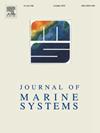高度分层系统中湍流混合的空间变异性
IF 2.5
3区 地球科学
Q2 GEOSCIENCES, MULTIDISCIPLINARY
引用次数: 0
摘要
本研究研究了连接帕托斯泻湖和大西洋的高分层微潮里约热内卢格兰德海峡的环流、盐分布和混合过程的横向变化。在泻湖口附近的三个断面上收集了流速(ADCP)、水性质(CTD)和湍流动能耗散(微观结构剖面仪)的高分辨率观测数据。野外活动是在向海流条件下进行的,并在盐入侵边界上游(淡水/垂直均质)、盐入侵向陆地边界(盐楔尖端)和盐入侵下游(高度分层)的横截面捕获条件下进行的。虽然泻湖通常被认为是浅的,由正压动力学主导的混合系统,但我们的结果显示明显的分层,斜压过程起着中心作用。由斜压压力梯度和曲率和科里奥利加速度驱动的二次流增强了截面内的混合。底部产生的混合在所有样条中都很明显;然而,斜斜水平流速的垂直切变在第三(最下游)断面中成为主要的驱动机制。分层作用抑制了中游和下游截面上下层之间的混合,斜斜抑制了湍流,但在其界面上方和下方显示出更高的混合。值得注意的是,尽管通道漏斗效应增加了流向口的流速和剪切,但由于强烈的分层作用,混合并没有像预期的那样加剧。这些发现对于了解其他微潮河口的动态,特别是在堵塞的泻湖和狭窄的河道中,具有特别重要的意义。本文章由计算机程序翻译,如有差异,请以英文原文为准。
Spatial variability of turbulent mixing in a highly stratified system
This study investigates the lateral variability of circulation, salt distribution, and mixing processes along the highly stratified, micro-tidal Rio Grande Channel, which connects the Patos Lagoon and the Atlantic Ocean. High-resolution observations of current velocities (ADCP), water properties (CTD), and turbulent kinetic energy dissipation (microstructure profiler) were collected at three cross-sections near the lagoon mouth. The field campaign was carried out during a period of seaward flow conditions, and the cross-sections capture conditions upstream of the salt intrusion limit (freshwater/vertically homogeneous), at the landward limit of salt intrusion (the tip of the salt wedge), and downstream of the salt intrusion (highly stratified). While lagoons are often considered shallow, well-mixed systems dominated by barotropic dynamics, our results revealed pronounced stratification, with baroclinic processes playing a central role. Secondary flows driven by baroclinic pressure gradients and acceleration due to curvature and Coriolis enhanced mixing in the cross-sections. Bottom-generated mixing was evident across all transects; however, vertical shear of the horizontal current velocities at the pycnocline emerged as the primary driving mechanism in the third (most-downstream) cross-section. Stratification suppressed mixing between upper and lower layers at the midstream and downstream cross-sections, with the pycnocline damping turbulence, yet showing elevated mixing immediately above and below its interface. Notably, despite a channel-funneling effect that increased flow velocity and shear toward the mouth, mixing did not intensify as expected due to the strong stratification. These findings are particularly relevant for understanding dynamics in other microtidal estuaries, especially in choked lagoons and constricted channels.
求助全文
通过发布文献求助,成功后即可免费获取论文全文。
去求助
来源期刊

Journal of Marine Systems
地学-地球科学综合
CiteScore
6.20
自引率
3.60%
发文量
81
审稿时长
6 months
期刊介绍:
The Journal of Marine Systems provides a medium for interdisciplinary exchange between physical, chemical and biological oceanographers and marine geologists. The journal welcomes original research papers and review articles. Preference will be given to interdisciplinary approaches to marine systems.
 求助内容:
求助内容: 应助结果提醒方式:
应助结果提醒方式:


